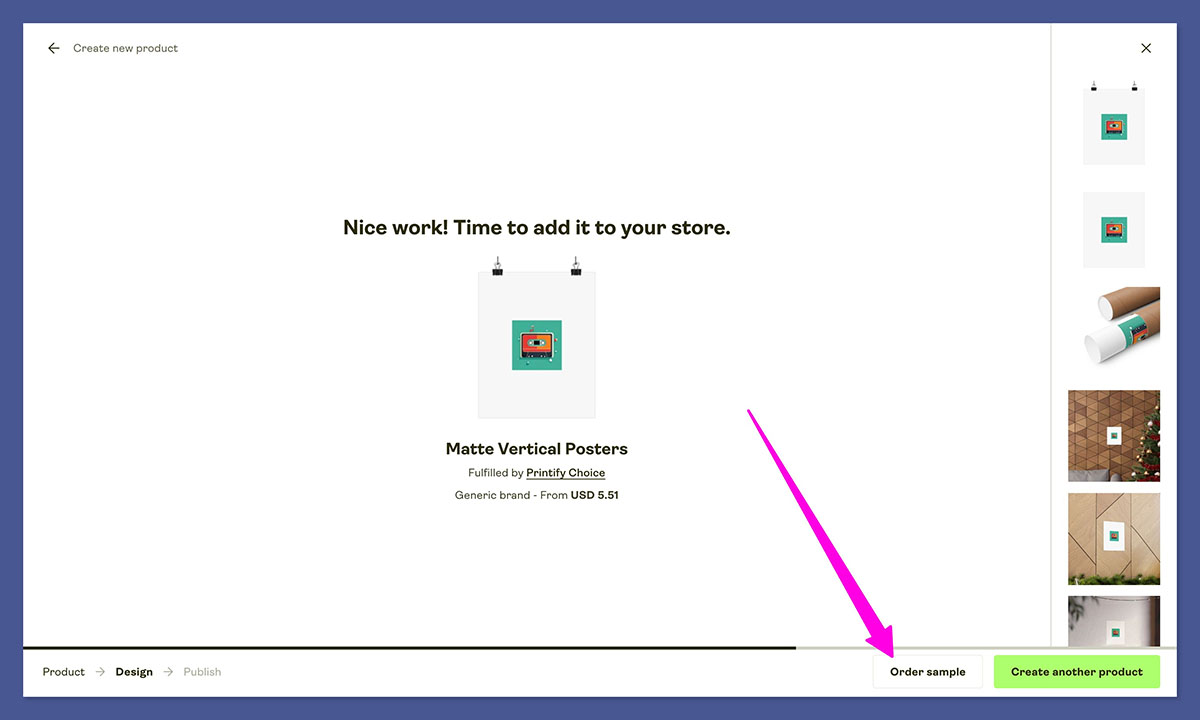Selling art online sounds exciting—until you list your work, get no traffic, and wonder what went wrong.
Most guides make it seem like all you need is an Etsy shop and some followers. But if you actually want to earn consistent income from your art, you need to treat it like a business.
This guide is specifically for artists who want to sell prints of their work online.
We’re not covering how to sell originals, commissions, or NFTs.
This is about turning your existing designs into scalable, shippable products—especially using tools like print-on-demand.
Whether you draw, paint, or design digitally, this is how to approach your art like a product, build systems that grow with you, and start generating actual sales.
TL;DR: How to Sell Art Prints Online
- Know your buyer before you create or list anything
- Start with one storefront (we recommend Etsy or Shopify)
- Use print-on-demand to avoid inventory headaches
- Price for profit, not just ego
- Build a brand your audience actually remembers
- Focus on qualified traffic, not just followers
- Protect your work—but don’t let fear stop you
- Use systems to grow without burning out
1. Know Your Audience Before You Make Anything
Most artists make what they like, upload it, and hope someone out there buys it. But real sales come when you flip that: start with your customer first.
You’re not just selling art—you’re solving a decor or gifting problem for someone. If you know who they are and what they want, everything else (style, size, price) becomes easier.
Think like this:
- Who is this for—college students, young professionals, parents?
- Where will they hang it—kitchen, dorm, living room, nursery?
- What style are they drawn to—minimalist, retro, botanical, surreal?
- What price range do they usually shop in?
You don’t need to guess. You can find these answers by doing simple research.
Research Checklist:
- Search Etsy and Pinterest using your art niche—see what’s trending
- Read reviews on popular print listings—what do people love or hate?
- Join niche Facebook groups or Reddit threads where buyers hang out
- Pay attention to sizing, color palettes, and themes that show up repeatedly
2. Choose One Platform to Start (Then Grow From There)
There are tons of platforms to sell art—Etsy, Shopify, Redbubble, Society6—but if you try to use all of them at once, you’ll burn out fast.
Start with one storefront and make it work. Focus on getting your listing quality, images, and product descriptions tight before you expand.
Want a full breakdown? Check our article on [Where to Sell Art Online].
Key Questions to Ask:
- Do I want more control or more built-in traffic?
- Am I okay managing my own site, or do I want a plug-and-play marketplace?
- Will I do my own marketing or rely on the platform to bring buyers?
Setup Priorities:
- Group products into collections (e.g. “Neutral Prints for Bedrooms”)
- Use mockups with scale—don’t just show flat artwork
- Keep descriptions clear and simple—include size info, materials, and shipping details
- Collect emails from day one using pop-ups or discount codes
You can always expand later. But not until your first store brings consistent results.
3. How to Use Print-on-Demand Without Compromising Quality
Print-on-demand (POD) lets you sell prints without holding inventory or packing orders yourself. But many artists get burned by bad quality, slow shipping, or weak presentation.
To make print on demand work, you have to manage the process like a business owner, not just a creative.
Print-on-Demand Basics:
| Task | Who Handles It |
|---|---|
| Print & ship | POD platform |
| File quality | You |
| Mockups & photos | You |
| Customer service | You |
Before You Start:
Order samples from at least two providers, like Printful or Printify, to compare quality firsthand. Even great mockups can’t show print sharpness, color accuracy, or paper texture.

Check the packaging — is it secure and professional or cheap and unbranded? This affects how customers perceive your store.
Compare finishes like matte, semi-gloss, and archival. Match the paper type to your art style and price point.
Track shipping times to the US and internationally so you can set clear expectations and avoid unhappy buyers.
Testing early helps you catch problems before your customers do.
Presentation Checklist:
| Element | Why It Matters |
|---|---|
| 300 DPI files | Prevents pixelation or blur |
| Clean, realistic mockups | Builds trust and boosts conversions |
| Packaging details | Sets expectations and adds polish |
| Multiple size options | Opens up upsell and gifting potential |
Hypothetical Example:
If you’re selling a dreamy sunset print:
- Offer it in 8×10, 11×14, and 16×20
- Use a mockup showing it above a desk or bed
- Choose a matte finish to reduce glare
- Frame optional—but show it framed in photos
Treat POD like your backend fulfillment partner. You still need to own the brand experience.
4. How to Price Your Art Prints for Profit
Pricing your prints too low makes you look cheap. Too high, and no one buys.
The goal is to price for profit while matching what your customer expects to pay.
Simple Pricing Formula:
| Item | Cost Example |
|---|---|
| Print + packaging | $8 |
| Shipping | $4 |
| Platform fees | $2 |
| Profit margin | $10 |
| Total Price | $24 |
Round to $25 or $30 based on market trends and buyer psychology.
What Affects Perceived Value:
- Framed vs unframed (framed adds 40–50% to perceived value)
- Your brand story (why you made it, what it means)
- Packaging (use inserts or wrap to create a premium feel)
- Theme relevance (popular styles sell faster and for more)
Boost Average Order Value:
- Bundle offers like “3 for $60”
- Upsell framing or gift options
- Offer digital versions for instant delivery
Think like a product manager: margin matters.
5. Build a Brand Buyers Remember
Anyone can upload a print. What makes people come back is the brand behind the art.
That doesn’t mean a fancy logo. It means consistent visuals, voice, and values across everything you do.
Brand Identity Breakdown:
| Element | Purpose |
|---|---|
| Fonts & colors | Creates a recognizable look |
| Tone of voice | Builds trust and personality |
| Story | Connects with buyers emotionally |
| Collection themes | Helps people understand your value fast |
Brand Building Tips:
- Use the same fonts and color palette across your site, emails, and socials
- Create collections like “Calm Spaces,” “Desert Vibes,” or “Moody Nature”
- Share your process or workspace—people love to buy from real creators
- Keep your tone consistent whether you’re selling or storytelling
Your art gets attention. Your brand earns trust.
6. Best Ways to Market Your Art Prints Online
You don’t need millions of followers. You need the right traffic—people actively looking to buy art.
The best channels for art print sales are visual and searchable.
High-ROI Traffic Channels:
| Channel | Why It Works |
|---|---|
| Visual search, long-lasting traffic | |
| Great for storytelling and engagement | |
| TikTok | Behind-the-scenes + high reach potential |
| SEO (Google) | Steady traffic to product and blog pages |
| Converts followers into loyal customers |
Traffic Tips:
- Use long-tail keywords in product titles (e.g. “Neutral Abstract Print 11×14”)
- Post your mockups across platforms, adjusting captions slightly
- Collect emails with a discount or free download
- Start a blog or FAQ answering real buyer questions (“What’s the best size for gallery walls?”)
Traffic means nothing without intent. Focus on people ready to buy.
7. How to Protect Your Art Without Killing Sales
It’s smart to protect your work—but overdoing it can backfire.
Massive watermarks or holding back your best designs makes your store look unpolished.
Low-Risk Protection Tactics:
- Upload 72 DPI files for previews (blurry if printed)
- Add a small, tasteful signature in the bottom corner
- Disable right-click on your site
- Use Digimarc to track unauthorized use
Legal Protection Basics:
- Include a copyright notice in your store footer
- Keep timestamped originals and receipts
- Don’t panic if your work gets shared—most reposts = free exposure
Fear doesn’t grow your business. A smart balance does.
8. Quick Start Toolkit for Selling Art Prints
Here’s what I recommend to artists just getting started. You can swap out tools, but this setup works well for most.
| Tool | Use Case |
|---|---|
| Printful | Print-on-demand fulfillment |
| Shopify | Storefront + checkout |
| Canva | Art formatting + mockups |
| Klaviyo | Email capture + automation |
| Organic traffic + discovery | |
| Hotjar | Track visitor behavior |
You can build a lean, profitable art business without touching inventory.
9. Artist vs. Art Entrepreneur: The Mindset Shift That Changes Everything
You don’t need to change who you are—you just need to change how you operate.
Artist Mindset:
- Makes what feels good
- Hopes it sells
- Avoids marketing
- Gets frustrated by slow results
Art Entrepreneur Mindset:
- Knows their audience
- Designs for demand
- Markets with confidence
- Builds systems for growth
This shift doesn’t mean selling out—it means staying sustainable.
Final Thoughts
You don’t need to go viral or get lucky to sell art prints online.
You need a clear target customer, a solid storefront, quality presentation, and a brand people trust.
Keep it simple, start small, and treat your art like a product.
Because when you approach this like a real business, it becomes one.






